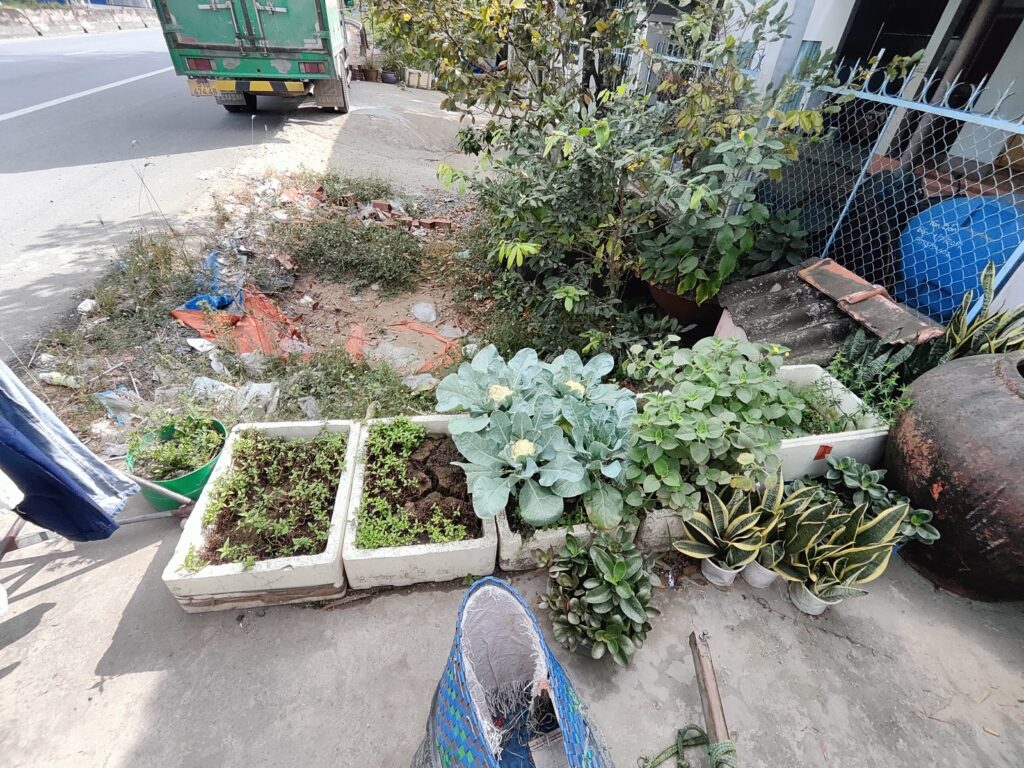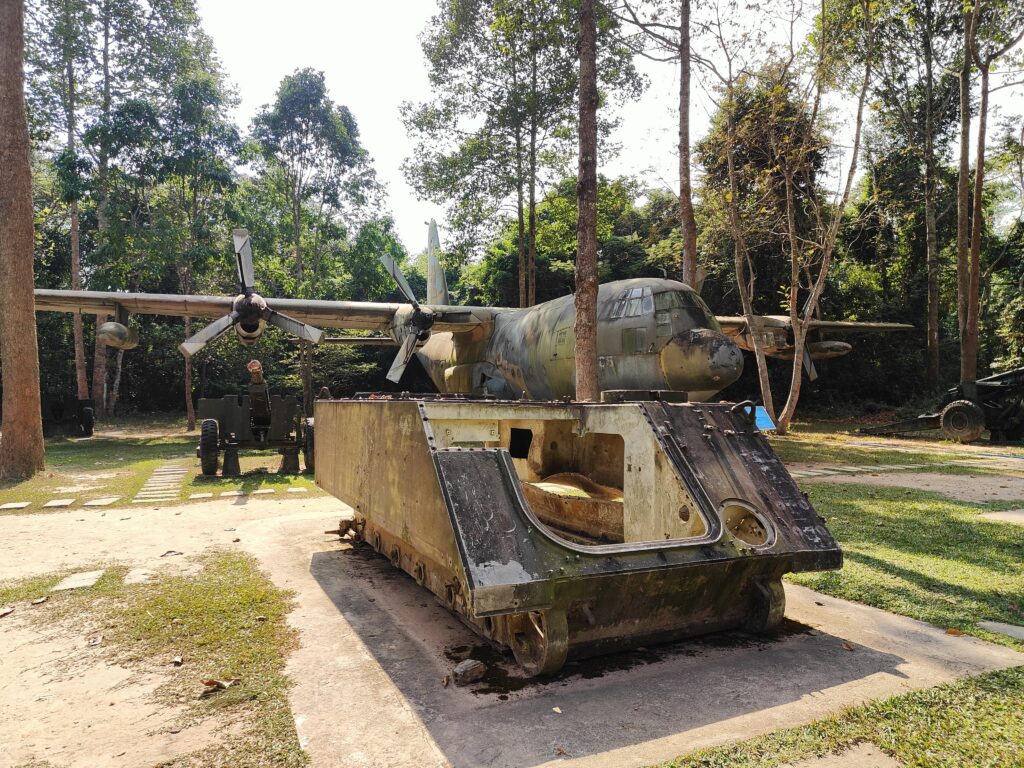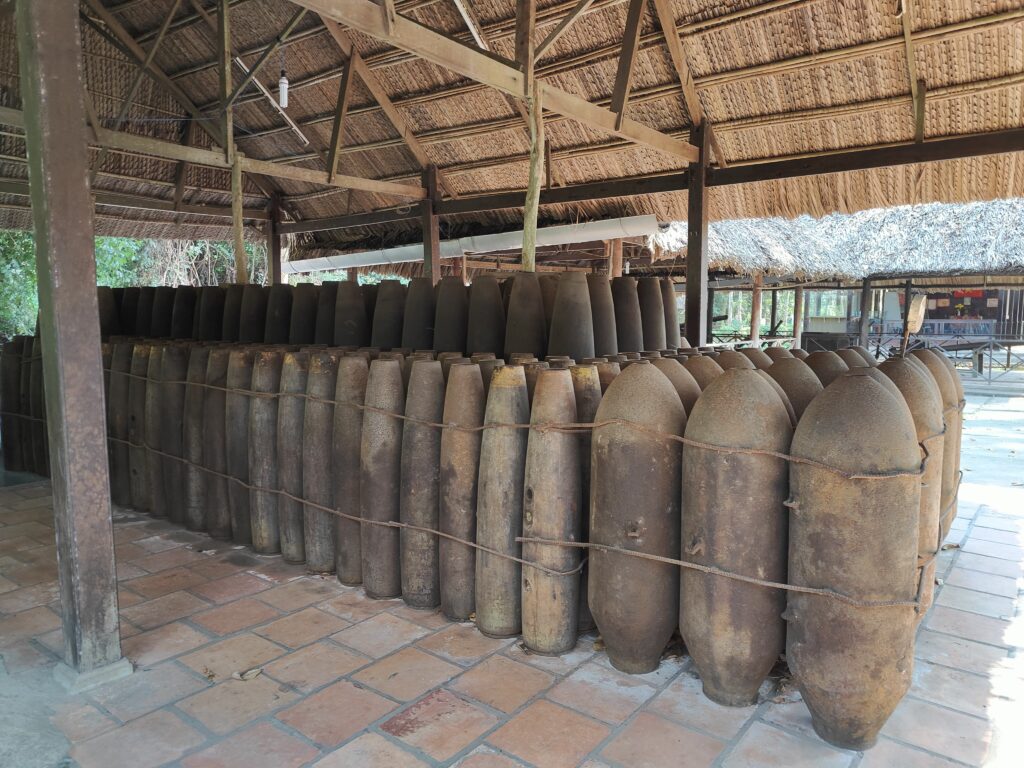Tour of Vietnam 2023 | Day 21 | Ca Mau – Cu Chi – Ho Chi Minh – | 388 kms

I wake up around 5:30 am, take a bath, and get ready. My jacket and riding pants have dried after getting soaked in yesterday’s rain. I enjoy my usual coffee before heading out. By 7 am, the streets are bustling, and the sun is shining brighter. The aroma of meat skewering over hot charcoal fills the air, and children are everywhere. After 20 minutes, I finally hit the open roads, leaving Ca Mau behind. I aim to cover as much distance as possible before needing a break. The fresh, cool morning air feels good against my face, and I’m driving at 60-80 km/h with minimal traffic. I’ve directed Google Maps toward Cu Chi, where I’ll explore the famous underground tunnels used by Vietnamese soldiers during the Vietnam War, a distance of 310 km. I take my first pit stop in Binh Minh town after driving 142 km, arriving at 9:15 am. I start with an energy drink, followed by a hot cup of coffee, and the shack owner kindly lends me hot water and a mug to brew it.

Most of the roads toward Cu Chi are new, surprisingly flat, and incredibly smooth, allowing me to maintain a constant bike speed of 70-75 km/h. They are mostly single carriageways. I decide to stop again after another 100 km. Leaving the main roads, I take smaller inner roads; while some sections are well-maintained, others are completely off-road, reminiscent of yesterday’s paths. To distract myself from the road conditions, I focus on the scenery around me.

A canal runs parallel to my road, supplying water to numerous waterlogged farms. Occasionally, a boat transports harvested pineapples to the dock connected to the main road. Pineapple cultivation is widespread in this area, with crops grown on raised soil beds that have water at their base. Long parallel bays of these raised beds are spaced wide enough for a mid-sized boat to navigate while harvesting. As I drive along the main road, I see large piles of pineapples ready for sale, with some being packed and loaded onto trucks.

After some time, I rejoin the good roads and maintain my speed. Soon, I stop at a roadside shack to enjoy some pineapples displayed nearby. The girl at the counter offers me sliced pineapples sprinkled with chili powder and salt in a plastic jar for 10,000 VND, and they taste delicious. One serving isn’t enough, so I have another, almost skipping lunch as I head toward Cu Chi village. Eventually, I reach the village outskirts and redirect to the Cu Chi tunnels. Upon arrival, I park my bike in an open lot and head inside, noticing only one car and two bikes around. I ask a man near the parked bikes for directions, and he points the way, giving me a sense that something is off. Ahead, I see a large gate and cross a bridge flanked by lotus ponds. To the north stands a substantial building, which Google Maps identifies as the Vietnamese War Memorial Complex.

I see 2-3 people milling around the entrance. A woman at the desk informs me that entrance is free. I step inside to find an empty hall adorned with memorial plaques on the walls, commemorating those who lost their lives in the brutal war. The floor is bare, and it is the walls that are decorated with the plaques honoring the heroes.
I leave the hall and ask the lady for the tunnels’ location. She instructs me to head outside, drive about 2 km north of the complex, and assures me that the tunnel entrance is separate, despite all the attractions being nestled within the vast natural forest. I quickly hop on my bike and head to the entrance.
I find the location easily thanks to the map directions. There’s a dedicated parking lot filled with vehicles, and the ticket counter is right outside the entrance. The fee for the tunnels is 125,000 VND, which I pay before walking 600-700 meters to the tunnel entrance. To my left, I notice a large shelter housing various unexploded bombs, ranging in size from small to massive ones taller than I am.






The large ones can be terrifying. Just imagining them falling nearby sends shivers down my spine. I find the entrance, which leads to an open area filled with war remnants, including a damaged tank, an intact tank, a support helicopter, and a cargo plane. I examine them closely and spot bullet holes on many. A staff member guides me through a dense jungle for about two minutes to the tunnels. Everywhere, I see bomb craters, each around 5 to 10 meters in diameter. A group of tourists stands in a circle, peering down at a rectangular wooden manhole measuring barely 1.5 feet by 1 foot. As it opens, I see a person emerging, both hands pointed skyward—his only way out. He challenges us, but no one accepts except me. I hesitate, wondering if I can fit inside with my riding jacket and hydration pack, but after some struggle and scraping my elbows, I manage to squeeze in. They close the lid, plunging me into instant darkness, though I’m relieved to find lights inside.

A claustrophobic person would faint immediately in these cramped tunnels, which measure barely 3′ by 4′ in a semi-circular arch, requiring a duck walk to move forward. It’s hot and damp as I lurch ahead. I imagine what it was like for soldiers during wartime, enduring long periods underground while bombs fell just meters above. Most people couldn’t endure such conditions for long. A salute to those who faced that reality.
I emerge from the tunnel, finding that coming out is more challenging than going in. I must simultaneously pull both hands out and then hoist myself out, causing me to sweat from the effort. The tunnel walk is only about 10 meters, he explains while showing us other bunkers. One bunker serves as a medical room, while another is a resting place for generals. These areas can only be accessed via tunnels, all hidden under camouflage and shaded by trees. The tunnels were constructed to support the people of Cu Chi village, which was a target for bombing.

The guide challenges us with the longest tunnel, measuring up to 30 meters. Some volunteers step up, and this proves to be a significant physical and mental test. After a few meters of duck walking, I begin to sweat. Even this movement becomes exhausting, so I switch to crawling on all fours. The experience is grueling, requiring us to navigate tight turns, with one descent adding to the challenge. Finally, we emerge onto an open platform, inhaling fresh air as sweat drips down my face.
The guide then shows us some makeshift traps created by the villagers and soldiers to torture US soldiers, marking the end of the tunnel exploration as I head back to its gated entrance.
The shooting range booking office is in front of me. A few days ago, a friend told me to try shooting since there’s a range in this park. The cost for all guns is 60,000 VND per bullet, with a minimum order of 5. I select the AK47 and book a round of 5 bullets for 300,000 VND. A nearby French man also books a handgun, making us the only two customers at the moment. An electric shuttle takes us to the shooting range at the edge of the forest. We check in, and our shooting slot is available in 5 minutes.
I go first to collect my earplugs. Five minutes earlier, I had heard the deafening sound of AK47 fire. The support staff confirms the gun is loaded and gives me the green light. I pull the trigger, and the bullet whizzes past, embedding itself in the sand behind the target. I feel like I’m on a battlefield and am ecstatic to fire such a famous gun for the first time. It’s a unique experience for me. My friend from France records my video as I shoot the remaining four bullets one by one, none hitting the target, with one just barely missing.


After we finished, we were both taken back to the same spot. I said goodbye to my French friend Stephan and headed to the parking lot. I had accomplished what I came to see and experience, so I decided to return to Ho Chi Minh City. The distance was 60 km, and it was around 4 PM.
The ride home was tough; the last 20 kilometers felt like hell in the city traffic as everyone returned home. There was no breeze, and the bumper-to-bumper congestion, combined with the heat radiating from the engines, made it unbearable. I was sweating profusely and longed for a cold shower. Those 20 kilometers felt like 200 in that maddening traffic. I finally reached Nihal’s place around 7 PM, freshened up, and we headed out for dinner at a popular Vietnamese restaurant. We ordered ‘Pho’ and received it promptly.

The hotel is preparing for the evening rush as customers start to arrive. We conclude with a cup of green tea I’ve grown fond of, enough to capture a photo and pledge to search for it in the market to bring back to India.

We return to the room, where Nihal, feeling tired, goes to sleep. I head to the Highlands Coffee shop to work on my diary. After about two hours, it’s time for the shop to close, so I return to the 24th floor. I struggle with the RFID entrance key for a while, unable to unlock the door, and Nihal’s phone is unresponsive. After several attempts, I finally manage to open the door.
I’m heading to bed without an alarm since tomorrow is a big rest day. I’ll be exploring the city and doing some shopping.




